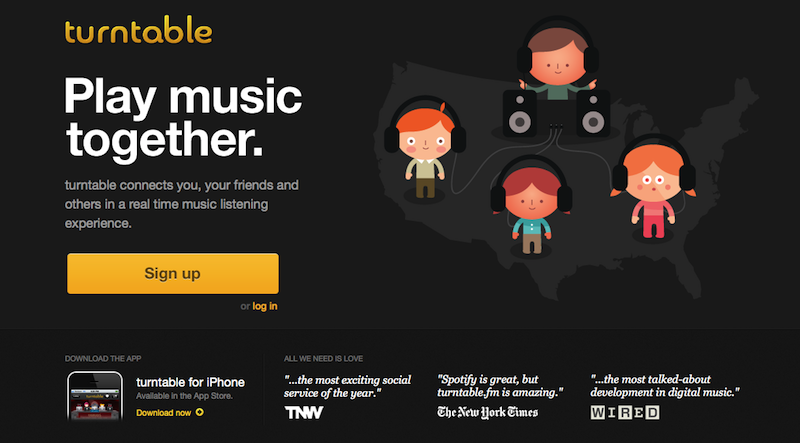

Turntable.fm is perhaps the most innovative and interestingly designed website presented in this analysis. Its users interact with each other through virtually convening in ‘rooms’, in which various artists are featured for visitors to listen to for free. Even some celebrity artists such as Tech N9ne and Sir Mix-A-Lot have created their own ‘rooms’ and perform for online listeners. Turntable.fm is also an excellent example of a good tech startup idea blowing up in popularity in a matter of weeks due to endorsements, marketing, and advertising. According to an article from Billboard written by Jeff Benjamin, Erica Thompson, and Carly Wolkoff released in 2011, “Turntable.fm hasn't even officially launched and it already boasts more than 350,000 users--everyday music fans are there, along with agencies, record labels and media outlets. While many users are just having fun spinning tracks, some are utilizing the site as a platform to premiere and promote new music and products.” (Benjamin, Thompson, & Wolkoff, 2011) Although as the above excerpt mentions, some musicians are using Turntable.fm as a place to get their media out in the world, the primary purpose of the site is for entertainment. An important aspect of this tech startup is the fact that it relies heavily on avatars. Giving users the ability to create digital representations of themselves introduces an exciting appeal. Not only does the homepage sport a huge yellow ‘Sign up’ button and an inviting and playful font style, but the primary mortise is a group of happy an awed avatars listening to the DJ superimposed over a silhouette of the United States. The entire scene screams ‘fun!’ to the potential user, and is yet another example of how this style of approachable and stimulating interface can be key to creating a prosperous entertainment-based tech startup. Keng Ching-Jui, and Chia-Chien Liu found in a study analyzing the effectiveness of online advertising that makes use of features such as avatars that, “subjects prefer medium-complex advertising comprising ‘3D advertising elements with an avatar’ or ‘2D advertising elements with self-referencing’: high-sensation seekers and low-need-for-cognition viewers prefer the former, whereas low-sensation seekers and high-need-for-cognition viewers prefer the latter.” (Keng Ching-Jui, & Chia-Chien Liu, 2013) This supports the thesis of this analysis because it is obvious from Turntable.fm’s homepage that they are attempting to pander to users who fall under the category of ‘high-sensation seekers’. In addition, avatars help create a space which is essentially a kind of virtual reality, such as the online game Second Life. Leone Massimo found that the use of avatars made the game even more exciting and successful in his study entitled The Semiotics of Religious Space in Second Life. He found that, “virtual reality are often conceived by their adepts: a space of total freedom, isolated from the ‘real world’ of the First Life, yet linked with it through a thin column of hardware and software.” (Massimo, 2011)
The Turntable.fm mobile application login page shown here shares the same color scheme. It even provides the option to login with Facebook, which shows the user’s friends on Facebook that they are using the service. Again, this gives the user a sense of connectedness and familiarity with the app. The only missing element in this image is the inclusion of the aforementioned avatars. However, considering the physical size constraints of smartphones, this is hardly a surprise. Still, the jovial and accepting attitude of the company is remains intact.
